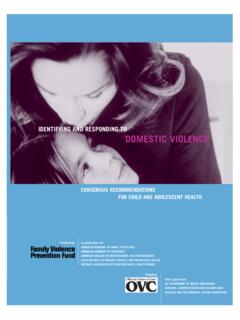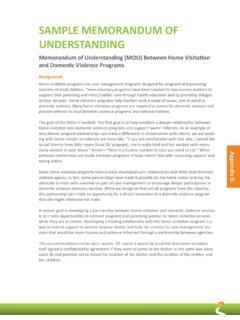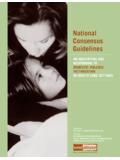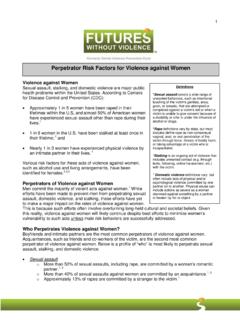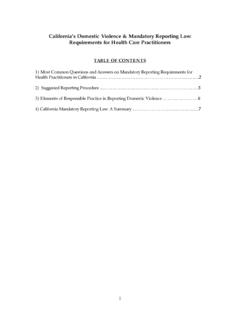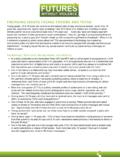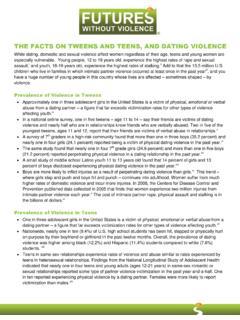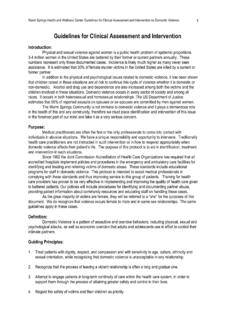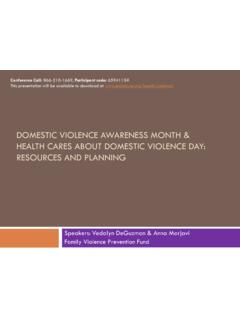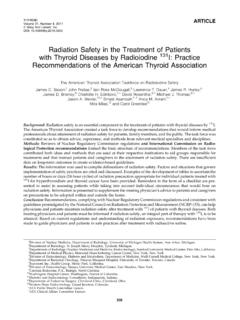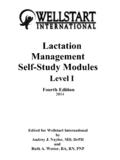Transcription of Compendium of State Statutes and Policies on Domestic ...
1 Compendium of State Statutes and Policies on Domestic Violence and Health Care Produced by: Funded by: The Administration for Children and Families, Administration on Children, Youth and Families, Department of Health and Human Services Points of view or opinions in this document do not necessarily represent the official Policies of the Department of Health and Human Services. Compendium of State Statutes and Policies on Domestic Violence and Health Care Authored by: Nancy Durborow, MA, Consultant Kristine C. Lizdas, JD, Managing Attorney, Battered Women's Justice Project Abigail O'Flaherty, Graduate Health Intern, Family Violence Prevention Fund and Juris Doctor Candidate 2011, University of San Francisco School of Law Anna Marjavi, Program Manager, Family Violence Prevention Fund Many thanks to the dedicated Domestic Violence/Sexual Assault State Coalition staff who sent copies of their State laws and regulations for inclusion and provided feedback on this Compendium .
2 With heartfelt dedication to victims and survivors of Domestic and sexual violence. We hope this Compendium helps promote effective Policies and regulations to support the health, healing and wellness of survivors of abuse. To view a PDF of this publication and other related tools, visit: The publication was produced by: The Family Violence Prevention Fund The Family Violence Prevention Fund works to prevent violence within the home, and in the community, to help those whose lives are devastated by violence because everyone has the right to live free of violence. 2010 Family Violence Prevention Fund. All rights reserved. Family Violence Prevention Fund Table of Contents Introduction and Methodology .. 1. Quick Chart: State Statutes and Policies on Domestic Violence and Health Care .. 7. Summaries of State Statutes and Policies on Domestic Violence and Health Care .. 9. Material Order & Feedback Form.
3 69. About the National Health Resource Center on Domestic Violence For more than two decades, the National Health Resource Center on Domestic Violence has supported health care practitioners, administrators and systems, Domestic violence experts, survivors, and policy makers at all levels as they improve health care's response to Domestic violence. A project of the Family Violence Prevention Fund, and funded by the De- partment of Health and Human Services, the Center supports leaders in the field through groundbreaking model professional, education and response programs, cutting-edge advocacy and sophisticated technical assistance. The Center offers a wealth of free culturally competent materials that are appropriate for a variety of public and private health professions, settings and departments. For free technical assistance, and educational materials: Visit: Call toll-free (Monday-Friday; 9am-5pm PST): 888-Rx-ABUSE (888-792-2873).
4 TTY: 800-595-4889. Email: Compendium of State Statutes and Policies on Domestic Violence and Health Care Family Violence Prevention Fund Introduction and Methodology For two decades, the Family Violence Prevention Fund (FVPF) and the National Health Resource Center on Domestic Violence through its publications, practices, educational programs, and outreach efforts, have promoted routine assess- ment for Domestic violence and effective responses to victims in health care settings. During the past twenty years, there has been a growing recognition among health care professionals that Domestic violence, also known as intimate partner violence, is a highly prevalent public health problem with devastating effects on individuals, families and communities. Most Americans are seen at some point by a health care provider, and the health care setting offers a critical opportunity for early identification and even the primary prevention of abuse.
5 In 2001, the FVPF produced the first State by State Legislative Report Card on Health Care Laws and Domestic Violence. This new Compendium of State Statutes and Policies on Domestic Violence and Health Care updates and replaces that earlier publication. The Compendium is an at-a glance summary of State laws, regulations and other activities relevant to address- ing Domestic violence in health care settings. It includes new analyses and themes that reflect policy and programmatic changes made in the last decade by leaders in the fields of health care, policy and Domestic /sexual violence advocacy. The FVPF invited staff from every State Domestic violence coalition to review their State 's summary and provide feedback; the Compendium reflects these comments. Relevant State laws were researched to ensure correct citations through both State legislative web pages and LexisNexus. The Compendium includes State -specific summaries that address the following areas: Domestic violence fatality review.
6 Mandatory reporting of Domestic violence to law enforcement by health care providers; insurance discrimination against victims of Domestic violence; health care protocols addressing Domestic violence; screening for Domestic violence by health care professionals and training on Domestic violence for health care professionals. Additional information is pro- vided where available on State public health programs, and funding opportunities. While State law is an important component of addressing Domestic violence in the health care system, it is important to note that throughout the many collaborations with State Domestic violence coalitions, public health professionals, health care providers, managed care providers and local communities have undertaken new and exciting projects that are also providing critical support, safety and hope to Domestic violence victims receiving health care services.
7 A number of those State and local activities are highlighted in the State summaries. Below is a description of the type of laws outlined in the Compendium 's State summaries. Domestic Violence Fatality Review Fatality Review Teams Given the high death toll stemming from Domestic violence, many states and local municipalities have established Domestic Violence Fatality Review teams and projects. Participants on Domestic Violence Fatality Review Teams are multi-disciplinary and often come from a broad array of professions, including: government officials; public health professionals; law enforcement; health care providers including mental health professionals; Domestic violence advocates;. coroners; medical examiners; forensic pathologists and others. A Fatality Review Team evaluates cases of fatal and near fa- tal Domestic violence homicides, and sometimes suicide, to identify trends and patterns associated with Domestic violence fatalities.
8 These Teams also make recommendations for Domestic violence prevention, intervention, and investigation efforts and often monitor the implementation of those recommendations. Compendium of State Statutes and Policies on Domestic Violence and Health Care 1. Family Violence Prevention Fund The fatality review process assumes that the circumstances of untimely deaths are likely to be repeated and that de- tailed examinations can lead to important insights regarding risks, intervention, and prevention efforts. The process rests on the premise that in-depth analysis of a small number of cases can provide a window into system response problems, which may affect a larger number of people. The goal is a focused, multidisciplinary examination into the circumstances surrounding a fatal incident for insight into how future deaths may be prevented through strengthening system-level responses. State Laws It is important to point out that many State Domestic /sexual violence c oalitions, State governments and local munici- palities have established Domestic Violence Fatality Review Teams without legislative direction.
9 There are currently 26. states that have enacted this type of legislation. The State laws vary in the scope of coverage (local, regional or State level);. appointed members; the range of recommendations; and resources including funding. The Compendium lists each State with its corresponding fatality review law, and brief summaries of the laws. However, it is important to review the text of the entire law to understand authority, scope of practice, make-up of Fatality Review Team Members and available resources. Mandatory Reporting of Domestic Violence to Law Enforcement by Health Care Providers Reporting Abuse of Adults Most states have enacted mandatory reporting laws, which require the reporting of specified injuries and wounds, and suspected abuse or Domestic violence for individuals being treated by a health care professional. Mandatory report- ing laws are distinct from elder abuse or vulnerable adult abuse and child abuse reporting laws, in that the individuals to be protected are not limited to a specific group, but pertain to all individuals to whom specific health care professionals provide treatment or medical care, or those who come before the health care facility.
10 The laws vary from State -to- State , but generally fall into four categories: states that require reporting of injuries caused by weapons; states that mandate reporting for injuries caused in violation of criminal laws, as a result of violence, or through non-accidental means; states that specifically address reporting in Domestic violence cases; and states that have no general mandatory reporting laws. Implications for Victims of Domestic Violence With the increasing awareness about Domestic violence as a health care issue, attention has turned to how health care providers can best assist their patients through routine assessment, documentation, intervention and referral. Unfortu- nately, applying mandatory criminal injury reporting laws to Domestic violence cases is most often not helpful to domes- tic violence victims. Research indicates that the most critical elements of providing Domestic violence victims with quality health care responses include offering ongoing and supportive access to medical care, addressing safety issues, and guiding patients through available options.
